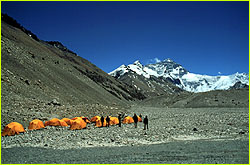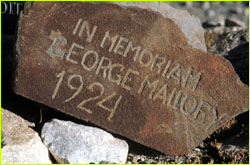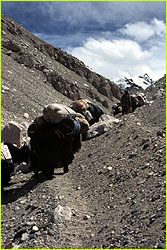
|
 |
 |
by Liesl Clark April 25, 1999 This isn't your usual Everest expedition, where sights are fixed on the summit, and all hopes are aimed at the highest node on Earth. (See "Up to Base Camp.") In fact, this week our talented team of Himalayan climbers is focused on a site some 2,000 feet below Everest's summit, an 825-foot-wide snow terrace at 27,000 feet. What they'll find there is yet to be determined (and possibly only four days away), but we think that at the foot of the Yellow Band on inclined scree, 800 feet below an ice axe found in 1933, lies the body of 1924 climber Andrew Irvine. Did Irvine fall to his death on his way down from the summit, or did he just lay down, exhausted, and die after a fruitless effort to be the first up Everest? The mystery of whether George Leigh Mallory and Andrew Irvine were the first climbers to stand on the summit of Everest has burned within mountaineers' hearts for 75 years. After a month of being on the peak—and ahead of schedule—our team is now poised to find answers: "We are in the unique position that we know better than before where to look for evidence, and we have the strongest team ever to attempt the search," commented researcher Jochen Hemmleb this morning as the last of our climbers headed off from Base Camp to Advance Base Camp.
The climbers left Base Camp in waves on the first leg of their journey to Camp V, from where they will base their first search attempt. Eric Simonson, Andy Politz, and expedition doctor, Lee Meyers, left yesterday in the early morning. Today, we said goodbye to Dave Hahn, Jake Norton, Tap Richards, and Conrad Anker as they all threw on their packs, weighed down with only bare essentials, for their eight-hour trek up the moraine of the East Rongbuk Glacier to Advance Base Camp. We (the film crew) are staying behind at Base Camp to film Hemmleb's communication with the team as he directs them via radio to the search site at 27,000 feet with the aid of his 200-X power telescope. Hemmleb, who has been studying this mystery for 12 years, knows every step of the way up to his proposed search site—without ever having set foot on Everest. A geologist, he has devoted his energies to solving the question of what happened to Mallory and Irvine by applying cartographic skills to the few photographs taken by expeditions after 1924 of the area in question - the place where a body was found by a Chinese climber in 1975. If rediscovered, this body, described as an "Old English" climber, may have a camera with it and images that will tell the long-awaited story of the demise of Mallory and Irvine.
"Our initial search efforts will be devoted to surveying the highest area of probability. We expect to be able to comb that area fairly exhaustively. We don't anticipate having a large amount of time up there. We think that since the area is so confined, a handful of people can do a reasonably good job in that area over a few hours." For Simonson, the tactic of sending the entire team up to Camp V—have them spend a night and then leave early in the morning the next day to climb up to the search site and conduct an initial search—is the best plan for a quick search without using up all of our oxygen supplies. Working at 27,000 feet is not easy, and the climbers will need to use bottled oxygen to help them function in the thin air above Camp V. "It's amazing what a boost the oxygen gives you," comments Simonson. "You feel warm, and you can think more clearly up high." It's the oxygen that we believe will help bring the entire team back safely after their first search. Check back as we follow the team's progress up to Camp V and then to the search site. Unanswered Questions (May 25, 1999) Forty-Eight Yaks (May 21, 1999) On Top of the World (May 17, 1999) Summit Team Moves Higher (May 16, 1999) Still at Camp V (May 15, 1999) Snow Bound (May 14, 1999) Outsmarting the Weather (May 13, 1999) Last Trip Up (May 12, 1999) Up to ABC/The Rescue (May 11, 1999) The Image of Mallory (May 8, 1999) In Extremis (May 7, 1999) Pieces of the Puzzle (May 6, 1999) Dearest George (May 5, 1999) Mallory's Discoverers Return (May 4, 1999) Mallory Reported Found (May 3, 1999) Waiting in Silence (May 1, 1999) Up to the Search Site (April 30, 1999) To the North Col (April 29, 1999) Waiting out the Wind (April 28, 1999) Search About to Begin (April 25, 1999) Pitching a 1933 Tent (April 23, 1999) Early Camp Found at 21,750 Feet on Everest (April 20, 1999) Up to Base Camp (April 23, 1999) Lost on Everest | High Exposure | Climb | History & Culture | Earth, Wind, & Ice E-mail | Previous Expeditions | Resources | Site Map | Everest Home Editor's Picks | Previous Sites | Join Us/E-mail | TV/Web Schedule About NOVA | Teachers | Site Map | Shop | Jobs | Search | To print PBS Online | NOVA Online | WGBH © | Updated November 2000 |
 Base Camp on the North side of Mount Everest
Base Camp on the North side of Mount Everest
 The mystery of Mallory and Irvine has been in the
hearts of climbers for 75 years.
The mystery of Mallory and Irvine has been in the
hearts of climbers for 75 years.
 A caravan of yaks makes its way to Advanced Base
Camp.
A caravan of yaks makes its way to Advanced Base
Camp.